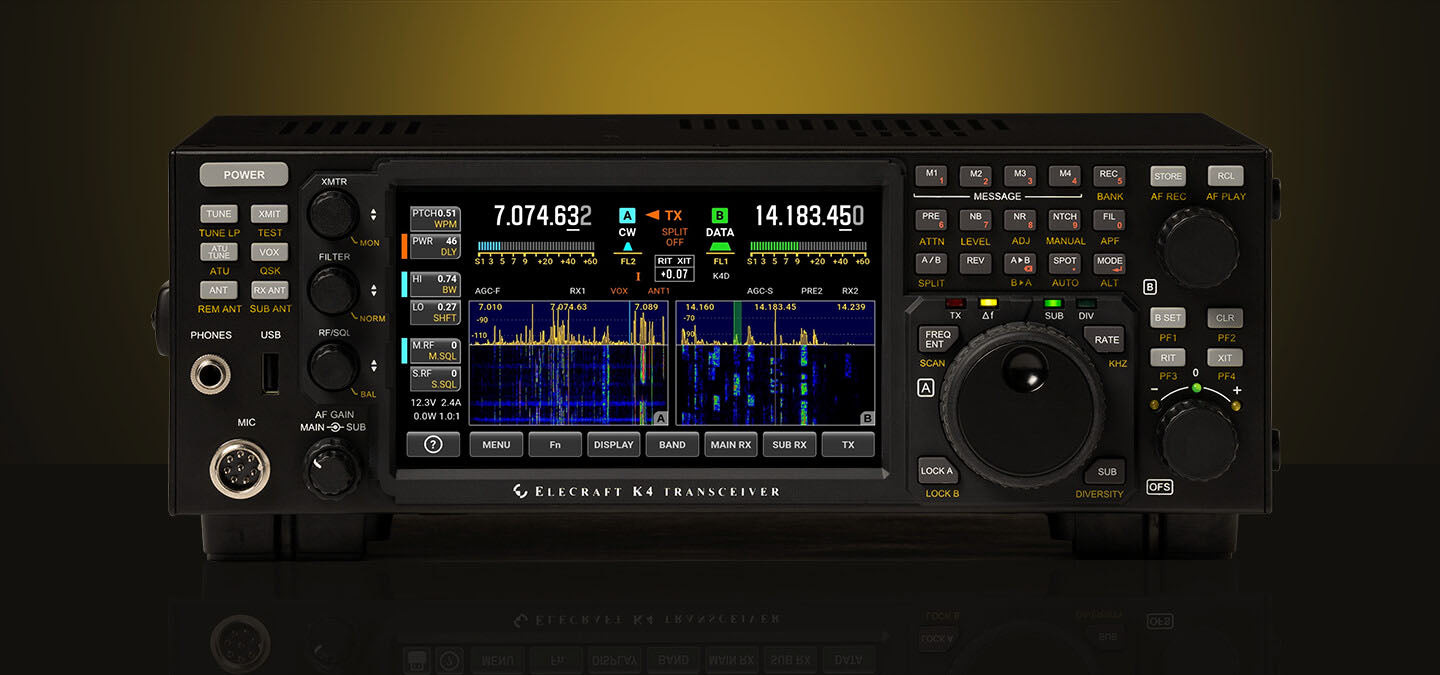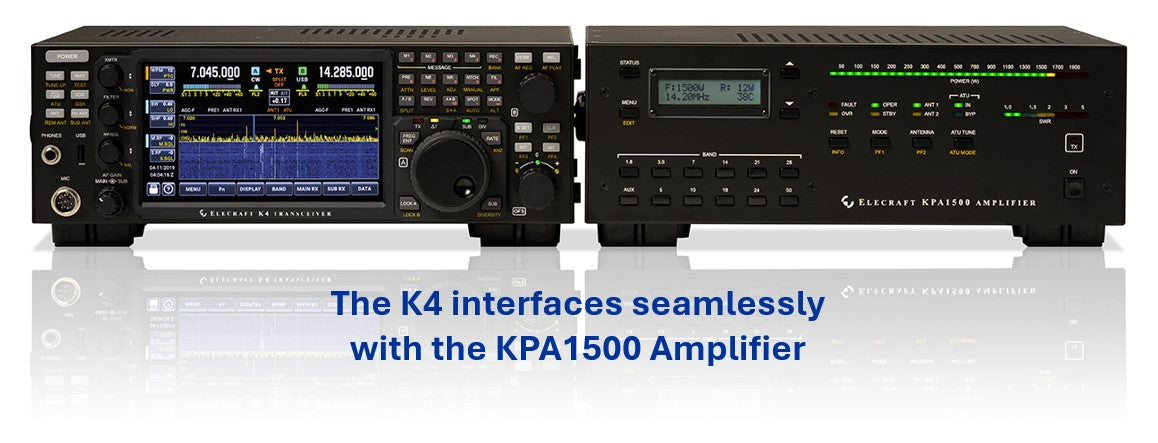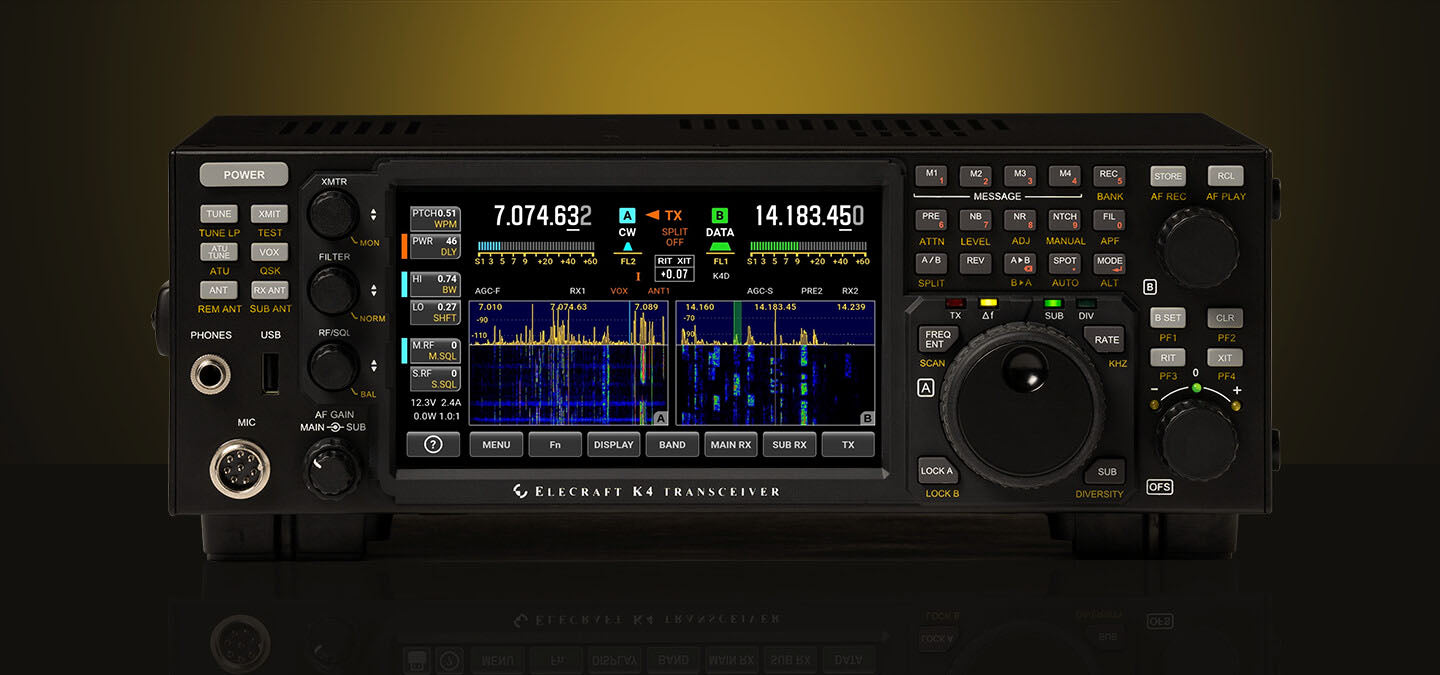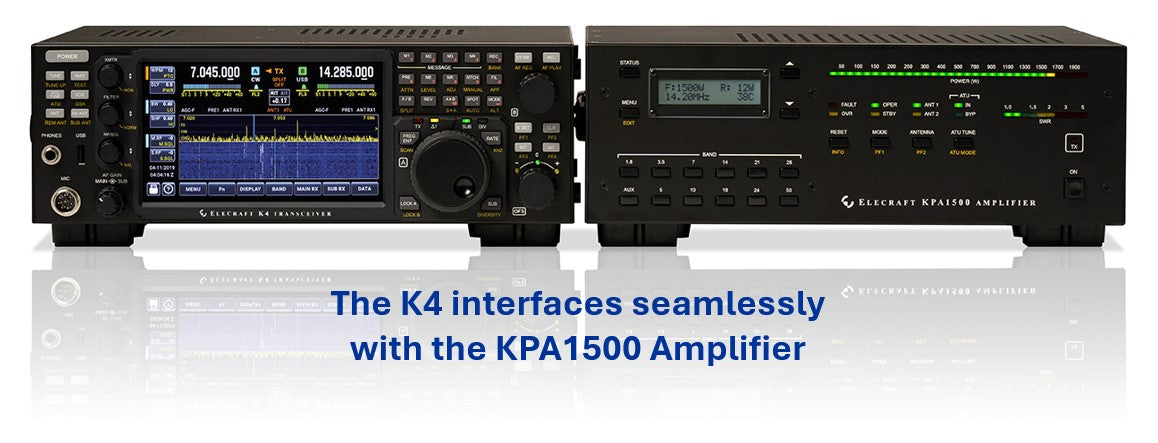K4 TRANSCEIVER
High-Performance Direct-Sampling SDR
Our new K4 doesn’t just harness the latest technology: it blends new tech with a classic user interface to create a transceiver that’s more than the sum of its parts. One that’s sophisticated yet civilized.
Like you, we’ve witnessed the recent revolution in direct sampling and SDRs. But rather than rush toward change, we’ve been observing — saving the best ideas, testing them, and quietly merging them into a new kind of radio. The resulting modular, hybrid design is innovative and versatile yet still a pleasure to use.
In particular, operators who’ve used our K3S transceiver and P3 panadapter will find the K4’s controls familiar, and its complement of I/O compatible with their existing station. But they’ll also discover a new level of convenience in the bright, 7” touch display, which combines a large panadapter with three intuitive multi-function controls. Everything you need is at your fingertips, including a unique built-in help system.
Save with K4D Packages!We've curated the most popular K4D options and accessories favored by Elecraft customers and assembled three K4D Packages designed to match your operating style. Explore the packages below and enjoy the savings! |
Available Now! Upgrade Option Kits
|
K4 to K4D Upgrade Option Kit The K4 to K4D Upgrade converts a base K4 into a fully independent dual-receiver K4D. K4toK4D Upgrade Kit Installation Video |
KPA4 K4 100 W Upgrade Kit Add the KPA4 100W Amplifier Module to a 10W K4. KPA4 Upgrade Kit Installation Video
|
K4 Demo Recordings
See Demo Videos on our YouTube Channel.
Please see the Shipping Status page for K4 shipping updates.
|




- Overview
- Models
- Packages
- Specs
- Options
- Reviews
- Manuals
- FAQ
- Price List/Order
Overview
A direct-sampling SDR you’ll love to use
Our new K4 harnesses the latest in signal processing while retaining the best aspects of the K3S and P3. The resulting user interface makes the technology transparent, allowing you to focus on working the world.
160-6 meter, all-mode coverage & dual RX
The K4 includes dual receive over 100 kHz to 54 MHz. Since it utilizes direct sampling, there’s no need for crystal filters in the K4 or K4D (see Models, back page). For extreme-signal environments, we offer a dual superhet module (standard in the K4HD). An internal VHF/UHF module is also planned.
High-resolution mini-pan for each receiver
Our advanced fine-tuning aid, with its resampled bandwidth as narrow as +/- 1 kHz, is displayed separately from the main panadapter.
Simple operation and setup
The K4 features a large, full-color touch display, combined with a rich set of real controls. Per-VFO transmit metering makes split mode completely foolproof. Band-stacking switches and per-receiver controls are both intuitive and versatile, adapting to operating context. Usage information on these and other features is just one tap away, thanks to our built-in help system.
Rich I/O complement
The rear panel includes all the RF, analog, and digital I/O you’ll need to complete your station. All K-line accessories are supported, including amps, ATUs, and our K-Pod station controller. The video output supports an external display with its own user-specified format.
Full remote control from multiple devices
The K4 can be 100% remote-controlled, via Ethernet, from a second K4 as well as a PC, notebook, or tablet. Panadapter data is included on all remote displays.
Modular hybrid architecture
The K4 adapts to your needs, with three models to choose from:
- Basic K4 with wide-range dual receive
- K4D with diversity receive
- K4HD with a dual superhet module for exceptional dynamic range
You can upgrade or add options as desired, or as new technology becomes available. This extensibility applies to software as well. The K4’s powerful CPU provides unlimited expansion opportunities.
Fast signal processing
The RF signal chain in the K4 incorporates parallel hardware processing of data streams, including a dedicated DSP subsystem. This, combined with silent, PIN-diode T/R switching, ensures fast CW break-in. Data and speech-processing delays are also minimized.
Standard DSP features include easy-to-adjust, per-mode RX/TX EQ; clean, punchy RF speech processing; full DVR capabilities; and several built-in data decode/encode modes. Direct-sampling technology results in an ultra-flat passband response for clean RX and TX audio. Since the signal chain is software-defined, the DSP can be field upgraded to add new algorithms and operating modes.
KAT4 ATU Option
The KAT4 ATU has a nominally 10:1 matching range. It includes 3 antenna jacks, any one of which can be selected as an input for one or both receivers.
Internal VHF/UHF module (future option)
An expansion slot is reserved for a high-performance VHF/UHF module (covered bands to be announced), with an output of approximately 15 W. This module will support all modes.
Models
The K4 adapts to your needs, with three models to choose from.
| Model K4 |
|
Basic K4 transceiver provides 160-6 m, all-mode coverage; 100 W output; five receive RF sources; and wideband dual watch, allowing the main and sub receivers to be set for the same or different bands. |
| Model K4D |
|
Adds KRX4 option, with a second set of band-pass filters and additional direct-sampling ADC module. This allows the two receivers to use different antennas – a requirement for diversity receive. Having two sets of band-pass filters also optimizes signal handling when the receivers are on different bands and/or antennas. |
| Model K4HD Coming Soon! |
|
Includes all of the above, plus our dual superhet module, the KHDR4. Ideal for competitive field day, contesting, and DXpedition stations. Each superhet receive section includes two crystal filters: one SSB/data bandwidth, one CW bandwidth. The superhet’s 8 MHz IF has an excellent dynamic range, so additional crystal filters are not required. |
Packages
| K4D PACKAGE 1 | K4D PACKAGE 2 | K4D/KPA1500 PACKAGE 3 |
| K4D Transceiver, Factory Assembled | K4D Transceiver, Factory Assembled | K4D Transceiver, Factory Assembled |
| KAT4 Auto-Tuner | KAT4 Auto-Tuner | KAT4 Auto-Tuner |
| MH4 Hand Held Microphone | K-Pod Control Panel | KPA1500 1500+ W Solid State Amplifier |
| $125 Package Savings! | MH4 Hand Held Microphone | K-Pod Control Panel |
| $175 Package Savings! | MH4 Hand Held Microphone | |
| Two (2) SP4 Speakers | ||
| KPAK3AUX - AUX Cable Set | ||
| ES100 K4 Carrying Case & Elecraft Luggage Tag | ||
| $300 Package Savings! |
Specs
STANDARD FEATURES
Size: 4.5”H x 13.5”W, 10” D
Weight: Approx. 10 lbs
Supply Voltage: 11-15 VDC
Current: 2-3 A RX, 4-23 A TX
Frequency Range: 100 kHz - 54 MHz (VHF/UHF range to be determined*)
Stability: +/- 0.1 ppm typ. (internal TCXO)
Modes: CW, SSB, AM, FM, Data
LCD: 7” color; touch & mouse control
Text modes: CW, PSK31/63, RTTY
KAT4 ATU: 10:1+ range; 3 ant. jacks
RX antenna sources: Up to 5
A-to-D Converter(s): 16 bit
I/O: USB-A x3, USB-B (two virtual com ports + audio), RS232 (DE9), Ethernet, video output. front/rear mic, front/rear phones, LINE in/out, speakers, PTT in, KEY out, paddle, key, ACC,12 V out.
CW QSK: Silent, PIN-diode switched
Other: RX/TX EQ, real-time clock,100% remote control including panadapter data, remote antenna switch control*, custom in-box software apps*
Reviews
|
Radcom K4 Review, November 2021. See it here! Ⓒ 2022 by RSGB This article is copyright of the Radio Society of Great Britain and reproduced with their kind permission. |
eHam Review - Review February 2022!
Manuals and Other Materials
- K4 Manuals and Other Materials
- K4 Software
- The Versatile KAT4 Automatic Antenna Tuner
- K4 to K4D Conversion Procedure Manual
FAQ
Q: What are the K4's basic capabilities?
A: The K4 is our new top-of-the-line transceiver, a direct-sampling SDR with a user interface that incorporates a large color LCD. It covers all ham bands from 160-6 meters, with planned coverage of VHF and UHF bands as a future option. Main and sub receivers each cover 100 kHz to 54 MHz. It operates in all modes (SSB, CW, AM, FM, and DATA), and includes built-in text decode/encode (CW, PSK31/63, RTTY). Power output is nominally 100 W (10 W for the QRP version). The KAT4 antenna tuner has 3 jacks, and there are up to 5 receive antenna sources. I/O is extensive, including video output, Ethernet, 4 USB ports, and a superset of K3S analog and control connections.
Q: All that and it’s still easily transportable?
A: Yes. Elecraft is committed to providing dual-use transceivers, even at the high end, in support of Field Day, DXpeditions, RV travel, etc. At 4.5 x 13.5 x 11.0” (less projections) the K4 is larger than a K3S, but it still weighs only about 10 pounds. It’s also very power-efficient for a radio in its class (2 A typical on RX) and can run from as low as 11 V, e.g. from a vehicle battery.
Q: Are there other products in the “new” K-Line?
A: Yes. There’s the K4’s companion amplifier, the KPA1500, as well as the new SP4 speaker, one or two of which can be directly connected to the K4. Both the amp and speaker are the same height as the K4 and have the same styling. The K4 is also compatible with our K-Pod station controller and MH4 microphone, as well as other K-Line gear such as the KPA500 amp and KAT500 ATU.
Q: How do K4 owners benefit from its modularity?
A: In two ways. First, you can tailor the K4 to your own requirements at the initial purchase, adding advanced options or upgrading to a K4D or K4HD at any time. (The three models and other options are discussed below.) Second, modularity allows Elecraft to quickly take advantage of new technology in the future by upgrading only the affected modules.
Q: Are there different models of the K4?
A: Yes: The K4, K4D, and K4HD. In most ways the three are identical. The K4D adds a second A-to-D converter and a second set of bandpass filters, allowing the radio to work in diversity mode or other situations where it’s beneficial to use separate antennas for the two receivers. (Thanks to direct sampling, neither the K4 nor K4D require crystal filters.) The K4HD adds a dual superhet module (discussed below), improving blocking dynamic range for high-signal conditions. Each of its two superhet sections has two crystal filters, one for SSB/DATA bandwidths and one for CW. Since each section has a high-dynamic-range I.F., no additional crystals are necessary. Note that a K4 can be easily upgraded by the user to a K4D, or a K4D upgraded to a K4HD, at any time. No soldering or alignment is required.
Q: How does the K4 compare, overall, to a K3S and P3?
A: The K4 retains virtually all of the operational features of the K3S and P3 while adding direct-sampling technology, wide-range dual receive as a standard feature, advanced I/O, and a large (7”) display with touch capability. With its high level of system integration, the K4 takes up about 4” less desk space (horizontally) than a K3S + P3. Despite this, the K4 is still easy to operate, thanks to optimal use of its display and context-sensitive controls. Most of the “hard” controls are similar or identical to those of the K3S, making them immediately familiar to anyone who has used a K3 or K3S. And unlike most transceivers in its class, the K4 has separate optical encoders for VFO A, VFO B, and RIT/XIT offset.
Q: Can a K4 be remote-controlled?
A: Yes. You can control a K4 from another K4, or from tablet/notebook/tablet computers, directly via Ethernet. No USB to Ethernet adapter is required. Panadapter signals are displayed on all remote-control devices.
Q: How does the K4’s CW performance compare to that of other direct-sampling SDRs?
A: Elecraft may be unique in the number of CW ops we have among our engineering staff. Nothing gets out of the Elecraft lab until it has silent T/R switching (PIN diodes, not relays) and fast, clean QSK. Some SDRs and direct-sampling radios have serious compromises in CW mode due to the use of T/R switching relays and long signal processing delays that make QSK impossible. The K4 uses fast parallel processing of digital signals to ensure low latency during T/R switching. In addition, there are many features for CW operation, including our high-resolution mini-pan tuning aid, dedicated one-touch message play switches, text decode/encode, top-level controls for setting pitch and code speed, adjustable keying weight, and an audio peaking filter (APF) that works like magic on weak signals buried in noise.
Q: Are there provisions for running software applications inside the K4?
A: Yes. The K4 incorporates a powerful, fast-booting, Linux-based computing module. This module manages the LCD and streaming I/O, including video output, Ethernet, etc. But it is also a general-purpose computer that can accommodate future in-box applications such as logging, external equipment control, even advanced data modes. Elecraft will seek input from the user community regarding such applications, then tailor them to the K4.
Q: Does this mean that the K4’s software is “open-source”?
A: No. But we’ll be providing an API (application programming interface) to allow selected developers access to internal resources. Any applications or other software contributed by third parties will be thoroughly vetted by our team before becoming available.
Q: How do superhet transceivers, like the K3S, differ architecturally from a direct-sampling radio like the K4?
A: A superhet depends on crystal filters to provide selectivity in both transmit and receive modes. The K4 uses true direct sampling at the RF input and achieves its selectivity through digital signal processing. In this scheme, a high-speed analog-to-digital (A-to-D) converter digitizes signals coming in from the antenna jack (we digitize at a rate of about 122 MHz). Signals in this form can be filtered, displayed, and demodulated using DSP techniques. This allows radio designers to add new operating modes, etc., without updating the hardware.
On the other hand, our K4HD model will give you the best of both worlds, adding a dual superhet module. It's a deal for stations that routinely experience high out-of-band signal levels due to proximity to shortwave (or neighboring ham's) transmitters. Each receiver is roughly equivalent to the K3S high-dynamic-range front end and IF. Each can be populated with up to three crystal filters. During operation, you can specify whether to use SDR or superhet mode. (For more on the K4HD, see the next FAQ item.)
Q: Are there performance differences?
A: In most circumstances, superhet and direct-sampling transceivers can both provide excellent performance and versatility. That said, here are the two most important differences: (1) In a direct-sampling radio like the K4, the DSP can “see” a wider bandwidth in its signal chain, allowing it to provide higher-performance noise reduction, noise blanking, advanced filtering, automatic signal tuning, and other advanced signal processing features. In contrast, a superhet’s DSP sees only the narrow bandwidth available at the output of its crystal filters, limiting it to audio-bandwidth signal processing. (2) The K3S, a superhet, has among the highest receive blocking dynamic range figures of any radio. The K4 can be outfitted with a dual superhet module that provides essentially the same performance if required. (See K4HD under "Models") This level of dynamic range is required only for stations that experience extreme signal levels, such as might be encountered in a high-power multi-transmitter installation without supplemental RF filtering, or if you’re next-door to an AM or SW broadcast station. Direct-sampling-only radios like the K4 and K4D can easily handle signals encountered by most operators during typical home or field use.
Q: I’ve heard the term “slice receiver” used in conjunction with direct sampling SDRs. Does the K4 use these?
A: Yes, but in the K4 this technology is strictly “under the hood,” implemented in a way that is transparent to the operator. Instead, you can just think in terms of the main receiver (VFO A), sub receiver (VFO B), and panadapter, as you would for a K3S and P3. But since you asked: A “slice receiver” is a digitized receive signal stream. With direct sampling, a single A-to-D converter can in theory provide any number of such digitized streams, simultaneously. The trick is using them wisely! In the basic K4, which has one high-performance 16-bit A-to-D, we extract three such streams. One is a wide bandwidth, used for the panadapter. The other two are for the main and sub receiver streams, which are demodulated by a high-speed DSP. These are the streams you listen to. In the K4D or K4HD, there are two A-to-Ds, providing more independence for the receive signal streams. We can use the second ADC’s panadapter stream to improve performance for dual-pan mode and use one of the second ADC’s demodulation streams to allow diversity operation, which requires two separate antennas. You can think of these as “slices” if you like (as will be explained in the theory of operation). But you won’t see this term on the radio itself or in the operating instructions.
Q: What are the K4’s DSP features?
A: DSP features include easy-to-adjust, per-mode RX/TX EQ; clean, punchy RF speech processing; full DVR capabilities; and several built-in data decode/encode modes. Direct-sampling technology results in an ultra-flat passband response for clean RX and TX audio. Since the signal chain is software-defined, the DSP can be field upgraded to add new algorithms and operating modes.
Q: Is it possible to use two independent receive antennas while using a third antenna for transmitting?
A: This is possible with the K4D or K4HD. (A basic K4 can be upgraded to a K4D at any time by adding the KRX4 option.) For example, the main receiver could use RX ANT 1, while the sub receiver uses RX ANT 2, or either could use one of the KAT4’s 3 antennas. The transmitter can also use any of KAT4’s antennas. Transmit, main RX, and sub-RX antenna selections are all clearly indicated on the display at all times.
Q: What are the features of the planned internal VHF/UHF module?
A: Variations on this internal module may cover one or two bands, including 2 m and 4 m. UHF band coverage may be available in the future. The target power level is about 15 W. The module will function in all operating modes. Controls for FM and repeater setup are included in the K4’s software. The ANT 4 jack on the rear panel is reserved for use with this module. If separate VHF and UHF antenna jacks are preferred, one of the 3 KAT4 antenna jacks could be repurposed for this.
Q: How many USB ports on the front panel?
A: The K4 has one USB-A on the front, two USB-A on the rear. If more inputs are needed, an external USB hub can be used on any of these.
Mouse, Keyboard, Flash Drive, etc. can be plugged into these ports.
The K4 also has one USB-B on the rear (with an internal sound card and multiple comm ports like the K3S).
Q: How many SO-239 connectors on the rear of K4? Photo shows 4 but I wonder if that’s the rear of a K4 or K4D?
A: All three K4 versions start with one SO-239 for Hf-6M. Three total when the KAT4 is added.
There is a 4th rear position for an antenna connector when a future planned VHF/UHF dual-band internal module is released later next year. That will accommodate a SO-239 or type N socket.
Q: Is there I/Q output for either or both VFOs?
A: Yes, over Ethernet.
KAT4 Auto Tuner Option FAQs
Q: What are the features of the KAT4 ATU?
A: The KAT4 ATU has a nominal 10:1 matching range. It includes 3 antenna jacks, any one of which can be selected as a receive input at a given time (bypassing the ATU’s L network). This selected antenna can then be used by either or both receivers, in addition to the other receive antenna sources (RX ANT 1 and RX ANT 2). The KAT4 stores up to 32 LC settings per ham band, recalling them instantly based on VFO frequency (recalled on transmit). In most home stations, ATU setup can be done one time for all bands/antennas.
Q: Does the K4 come with the ATU included?
A: Like on most of our radios, the KAT4 ATU is optional and can be added at any time. This allows those using the K4 full-time via an external amp with ATU and external antenna switching to lower their cost. This also applies to those who are dedicating a K4 as an IF radio for VHF/UHF/Microwave.





